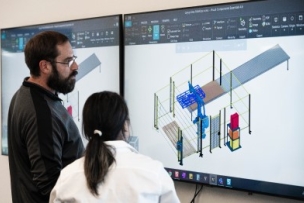With all the buzz around connectivity and “smart” factories, it appears as if the manufacturing industry is on the brink of a major shift. Some experts, as we reported here, are calling this Industry 4.0. Even companies in more mature industries like metal fabrication are starting to realize that the demands of today’s customers are not only changing the scope of their work, but the way in which they actually need to do their work.
“Investments in fabricating technology, information systems, and employees will be necessary to stay on top of the growing complexity in the metal fabricating business,” Dan Davis, editor of The Fabricator, says here in a recent editorial. “There’s no other way around it in this world of massive customization in manufacturing.”
While most industry leaders understand the capital and technology investments that may be necessary in the near future, many fail to realize the growing importance of investing in employees and, more specifically, in their training. In today’s lean manufacturing world, metal fabricators and other industry metal-cutting organizations have been conditioned to think in terms of efficiency. This means that secondary activities like employee training are often neglected because they don’t directly contribute to the bottom line.
However, as stated in the brief, “Strategies for Training and Maintaining Talent in Industrial Metal-Cutting Organizations,” research shows that investing in areas like training can provide a host of benefits, including better quality, faster on-time customer delivery, higher revenue per operator, and lower rework costs. “Put simply, companies can’t afford to neglect one of its greatest assets,” the brief states. “By investing resources into the workforce, industrial metal-cutting leaders can better equip themselves for today, as well as the future.”
For shops that want (or need) to beef up their training programs, an article from Foundry magazine provides some insight on what it takes to create an effective training program. According to the article, training programs should include a strong combination of education, engagement, and use: “Training must educate by teaching skills, transferring knowledge, cultivating attitudes and hitting other specific targets. But training that is purely educational doesn’t get results. That is why training must present information in ways that are engaging, interactive and require the learner to think and use the information learned.”
The article goes on to describe a method often used in training known as VAK Attack. VAK is an acronym describing the three ways people learn, as spelled out below:
- Visual learning happens when people watch materials that can include videos, PowerPoints, charts and other visual elements.
- Auditory learning happens when people learn by listening to people who might be other trainees, compelling trainers, visitors and others.
- Kinesthetic learning happens when people get out of their seats and move around as they take part in work simulations, games, and other meaningful exercises.
According to the Foundry article, effective training should include all three of the VAK principles so that employees can better learn and absorb the information presented. The author also suggests hiring an outside trainer to ensure long, impactful results. (You can read the full article here.)
It would be hard for anyone to ignore the advancements of the manufacturing industry; however, too many companies are ignoring the role employees play in today’s increasingly complex production environments. By investing in employees and their training, today’s metal fabricators can prepare for the future and, more importantly, stay competitive today.
- The manufacturing industry is on the brink of a major shift.
- The demands of today’s customers are not only changing the scope of their work, but the way in which they actually need to do their work.
- Industry leaders fail to realize the growing importance of investing in employees and, more specifically, in their training.
Previously featured on Blog.LenoxTools.com.



Talk to Us!
We have the plans to create a " Rotary skill grooming academy" we need right kind of input for such a trade. Subhash
24Leave a reply
Your email address will not be published. Required fields are marked *